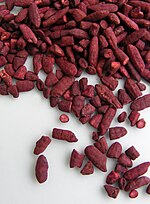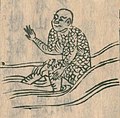Li Shizhen (July 3, 1518 – 1593), courtesy name Dongbi, was a Chinese acupuncturist, herbalist, naturalist, pharmacologist, physician, and writer of the...
11 KB (1,270 words) - 14:06, 15 September 2024
yeast rice is described in the Chinese pharmacopoeia Ben Cao Gang Mu by Li Shizhen. A modern-era use as a dietary supplement developed in the late 1970s...
24 KB (2,917 words) - 13:51, 18 January 2025
medicine, natural history, and Chinese herbology compiled and edited by Li Shizhen and published in the late 16th century, during the Ming dynasty. Its first...
11 KB (1,205 words) - 22:21, 25 January 2025
Li Shizhen's (1597) Bencao gangmu, the classic materia medica of traditional Chinese medicine (TCM), included 35 human drugs, including organs, bodily...
45 KB (5,988 words) - 13:45, 22 January 2025
medicine has drawn much of its foundation from Li Shizhen, the Korean practice was possibly derived from Li's work. Ouryuuto(黄竜湯) appears in a book called...
8 KB (928 words) - 23:41, 29 January 2025
Shi Guo (史国)) or Kesh, the present-day Shahrisabz, Uzbekistan. Whereas Li Shizhen, the compiler of the pharmaceutical Bencao Gangmu wrote that the beast...
41 KB (4,295 words) - 21:54, 20 November 2024
the niyu (鯢魚) is elaborated in a separate section. It has been noted by Li Shizhen that the character for the Niyu (Ni 鯢 fish) consists of the "fish" indexing...
34 KB (3,521 words) - 13:45, 13 December 2024
China, as early as 3rd century, to the book Wupu Bencao (around 239). Li Shizhen wrote the following in his Bencao Gangmu (1596): Come to think about it...
16 KB (1,868 words) - 02:13, 28 October 2024
梵言宮毗羅,音交。有鱗曰蛟龍。《抱朴子》曰:母龍曰蛟,龍子曰虯。其狀魚身如蛇尾,皮有珠。 "jiaolong 蛟龍", Li Shizhen 1596 "(Animals with) Scales I"; Li Shizhen 1782 "Vol. 43 (Animals with) Scales", Bencao Gangmu;...
68 KB (6,762 words) - 16:45, 29 January 2025
and feng 封 "an edible monster that resembles a two-eyed lump of flesh". Li Shizhen distinguishes 11 varieties of monkeys: A small one with a short tail is...
92 KB (14,026 words) - 21:46, 15 January 2025
the human body and "like to eat mercury". Li Shizhen (1596) "Bugs (Worms, Insects, Amphibians) 4"; Li Shizhen (1782) Book 42, "Bugs 4". The Chinese text...
27 KB (2,719 words) - 15:17, 31 December 2024
was taken to be used in preparation of ejiao for the emperor's court. Li Shizhen wrote in Bencao gangmu that ejiao is originally made from beef skin, but...
12 KB (1,356 words) - 20:25, 6 January 2025
historian of medicine Paul U. Unschuld, identifies the 貍 lí as the leopard cat. Li Shizhen cites Records of the Commanderies and States (郡國志)'s description...
12 KB (1,603 words) - 07:13, 31 July 2024
is also considered a medicinal wine in traditional Chinese medicine. Li Shizhen's Compendium of Materia Medica credits sweet osmanthus with "curing the...
5 KB (443 words) - 16:50, 22 November 2024
a dictionary. Li Shizhen (1596). "our-legged Animals II. Fengli" 獸之二 風狸 . Bencao Gangmu 本草綱目 (in Chinese) – via Wikisource. Li Shizhen (1782) [1596]....
50 KB (5,198 words) - 15:31, 31 December 2024
were being cultivated in China as early as the Tang dynasty (618–907). Li Shizhen, in his Pen Tsao Kang Mu, quotes Tang Ying-chuan from that period as saying...
10 KB (1,126 words) - 08:28, 2 January 2025
grown in the Yangtze River Delta region, but the Ming dynasty naturalist Li Shizhen popularized it by bringing attention to its medicinal qualities. The variant...
5 KB (529 words) - 00:17, 9 December 2024
Simiao of the Sui and Tang dynasties, Zhang Jiegu (c. 1151–1234), and Li Shizhen (1518–1593). Chinese communities living in colonial port cities were influenced...
220 KB (22,944 words) - 20:50, 30 January 2025
Siku Quansu version, vol. 1, p. 153 of 237 Li Shizhen, Bencao Gangmu, "vol. 51, section leopard (豹) Li Shizhen (author), Paul U. Unschuld (translator),...
8 KB (866 words) - 13:43, 1 December 2024
"wood ear"; "cloud ear fungus", Auricularia auricula-judae). The author Li Shizhen classified these six differently colored zhi as xiancao (仙草; "immortality...
43 KB (4,346 words) - 20:00, 29 December 2024
herbalist Li Shizhen's book Compendium of Materia Medica published in 1578, identifying jiaogulan supposedly for treating various ailments. While Li Shizhen had...
7 KB (761 words) - 06:37, 2 September 2024
historian of medicine Paul U. Unschuld, identifies the 貍 lí as the leopard cat. Li Shizhen cites Records of the Commanderies and States (郡國志)'s description...
9 KB (1,148 words) - 17:54, 7 September 2024
marvelous "iron-chewer" added to its cultural identity (2013: 224). Li Shizhen's 1596 Bencao Gangmu (Compendium of Materia Medica) section on animal drugs...
56 KB (8,176 words) - 17:32, 23 June 2024
"earthworm" lists alternate names of dilong and tulong 土龍 (see above). Li Shizhen notes these names derive from the myth that earthworms (like dragons)...
5 KB (640 words) - 14:38, 27 March 2023
The Compendium of Materia Medica written during the Ming dynasty by Li Shizhen says that horse meat is poisonous and may cause folliculitis or death...
114 KB (11,551 words) - 19:39, 31 January 2025
fungal infections of the skin and mouth. The human penis is not a drug. — Li Shizhen Human penis was previously believed under TCM to stop bleeding, and as...
60 KB (6,551 words) - 12:54, 2 January 2025
focuses on the greatest physician and pharmacologist in Chinese history, Li Shizhen, and his herbalist manual, Bencao Gangmu. Note: Some of the characters'...
4 KB (76 words) - 06:04, 5 August 2024
the 1596 Compendium of Materia Medica written by the Chinese polymath Li Shizhen during the Ming dynasty, the creation of tofu is attributed to the Han...
16 KB (1,906 words) - 03:27, 17 December 2024
According to Joseph Needham and Lu Gwei-djen, this content was Arabic, but Li Shizhen confused the story with a Burmese custom of preserving the bodies of abbots...
7 KB (915 words) - 17:38, 24 December 2024
ink from the soot of burning petroleum, which the later pharmacologist Li Shizhen (1518–1593) wrote was as lustrous as lacquer and was superior to pine...
18 KB (2,486 words) - 19:13, 29 January 2025























